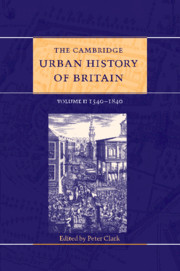Book contents
- Frontmatter
- 1 Introduction
- Part I Area surveys 1540–1840
- Part II Urban themes and types 1540–1700
- 5 Towns in an agrarian economy 1540–1700
- 6 Population and disease, estrangement and belonging 1540–1700
- 7 Politics and government 1540–1700
- 8 Reformation and culture 1540–1700
- 9 The urban landscape 1540–1700
- 10 London 1540–1700
- 11 Great and good towns 1540–1700
- 12 Ports 1540–1700
- 13 Small market towns 1540–1700
- Part III Urban themes and types 1700–1840
- Select Bibliography
- Index
- References
8 - Reformation and culture 1540–1700
from Part II - Urban themes and types 1540–1700
Published online by Cambridge University Press: 28 March 2008
- Frontmatter
- 1 Introduction
- Part I Area surveys 1540–1840
- Part II Urban themes and types 1540–1700
- 5 Towns in an agrarian economy 1540–1700
- 6 Population and disease, estrangement and belonging 1540–1700
- 7 Politics and government 1540–1700
- 8 Reformation and culture 1540–1700
- 9 The urban landscape 1540–1700
- 10 London 1540–1700
- 11 Great and good towns 1540–1700
- 12 Ports 1540–1700
- 13 Small market towns 1540–1700
- Part III Urban themes and types 1700–1840
- Select Bibliography
- Index
- References
Summary
the period 1540–1700 saw a transformation of the religious and educational institutions of English, Welsh and Scottish towns, and of the society and culture of their inhabitants. In Britain as in Europe, towns and urban society played an important part in the reformation of the Church and of its role in secular society, both in terms of institutional change and in popular and elite responses to it. Between 1540 and 1580, many of the basic institutional structures of medieval urban society were abolished or fundamentally altered. Important foci of community and civic life, such as fraternities, chantries and ceremonial, disappeared, and town populations and governments had to find a new collective spirit and new ways of organising their sociability. Many town governments came to be influenced by a Protestant or Puritan political ideology, which shaped their view of society and their response to its problems. The reformed Scottish Church achieved a very close relationship with secular urban governments, and set the agenda for action in many spheres, beyond those of religion and education. In the century and a half after the Reformation, religion continued to play an important part in the lives of townspeople in England and Wales, but the Church as a universal institution had been weakened, and the former unity of belief and observance was never recovered. Towns came to accommodate a multiplicity of beliefs and congregations. In the longer term the fragmentation of religious gatherings was paralleled by a decline in observance overall, a growing secularisation of society to which the increase in educational endowment and provision may have contributed.
- Type
- Chapter
- Information
- The Cambridge Urban History of Britain , pp. 263 - 288Publisher: Cambridge University PressPrint publication year: 2000



